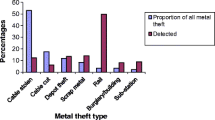Abstract
This chapter identifies the solvability factors for the seven types of metal theft offences committed on railway property in England and Wales and examines how they vary geographically in different British Transport Police (BTP) regions. The analysis of BTP data for 4001 metal theft offences committed between 2009 and 2010 enables nine significant solvability factors to be identified. The most important of these are checks with scrap metal dealers, covert police activities, witnessed offences, vehicle registration information and forensic evidence. Significant solvability factors explain 64% of the variation in detection outcomes. Detection odds depend on both the number of factors present in cases and their effect sizes. The number of solvability factors was a very good measure of incident solvability, with each extra factor improving detection odds fivefold. There were marked spatial variations in incident solvability and detection outcomes, some of which reflected metal offence type differences, solvability differences and apparent variations in investigative practice. The study indicates that statistical case-screening procedures would improve metal theft detection rates cost-effectively by informing police how to prioritise the allocation of resources to the most solvable cases and avoid applying investigative effort to cases that are unlikely to be solved.
Access this chapter
Tax calculation will be finalised at checkout
Purchases are for personal use only
Similar content being viewed by others
References
Bradford, B. (2012). Policing and social identity: Procedural justice, inclusion and cooperation between police and public. Policing and Society: An International Journal of Research and Policy, 24(1), 22–43.
Burrows, J., Hopkins, M., Hubbard, R., Robinson, A., Speed, M., & Tilley, N. (2005). Understanding the attrition process in volume crime investigations (Home Office Research Study 295). London: Home Office.
Cohen, J. (1988). Statistical power analysis for the behavioral sciences (2nd ed.). Hillsdale, N.J.: Lawrence Erlbaum.
Coupe, T., & Griffiths, M. (1996). Solving residential burglary (Police Research Group Crime Detection and Prevention Services, Paper 77). London: Home Office.
Dirikx, A., & van den Bulck, J. (2014). Media use and the process-based model for police cooperation. The British Journal of Criminology, 54(2), 344–365.
Eck, J. E. (1979). Managing case assignments: The burglary investigation decision model replication. Washington, DC: Police Executive Research Forum.
Greenberg, B., Elliot, C. V., Kraft, L. P., & Procter, S. H. (1977). Felony investigation decision model—An analysis of investigation elements of information. Washington, DC: US Government Printing Office.
Jansson, K. (2005). Volume crime investigations—A review of the research literature (Home Office Online Report OLR 44/05). London: Home Office.
Kochel, T. R., Parks, R., & Mastrofski, S. D. (2013). Examining police effectiveness as a precursor to legitimacy and cooperation with police. Justice Quarterly, 30(5), 895–925.
Kooi, B. R. (2010). Theft of scrap metal. Problem-Specific Guides Series, No. 58. US Department of Justice, Office of Community-Oriented Policing Services.
Robb, P., Coupe, T., & Ariel, B. (2015). ‘Solvability’and detection of metal theft on railway property. European journal on criminal policy and research, 21(4), 463–484.
Sidebottom, A., Jyoti, B., Bowers, K., Thompson, L., & Johnson, S. (2011). Theft in price-volatile markets: On the relationship between copper price and copper theft. Journal of Research in Crime and Delinquency, 48(3), 396–418.
Skogan, W. (2006). Asymmetry in the impact of encounters with the police. Policing and Society: An International Journal of Research and Policy, 16(2), 99–126.
Tilley, N., Robinson, A., & Burrows, J. (2007). The investigation of high volume crime. In T. Newburn, T. Williamson, & A. Wright (Eds.), Handbook of criminal investigation (pp. 226–254). London: Willan Publishing.
Author information
Authors and Affiliations
Corresponding author
Editor information
Editors and Affiliations
Rights and permissions
Copyright information
© 2019 Springer Nature Switzerland AG
About this chapter
Cite this chapter
Robb, P., Coupe, R.T., Ariel, B. (2019). Metal Theft Solvability and Detection. In: Coupe, R., Ariel, B., Mueller-Johnson, K. (eds) Crime Solvability Factors. Springer, Cham. https://doi.org/10.1007/978-3-030-17160-5_7
Download citation
DOI: https://doi.org/10.1007/978-3-030-17160-5_7
Published:
Publisher Name: Springer, Cham
Print ISBN: 978-3-030-17159-9
Online ISBN: 978-3-030-17160-5
eBook Packages: Law and CriminologyLaw and Criminology (R0)




